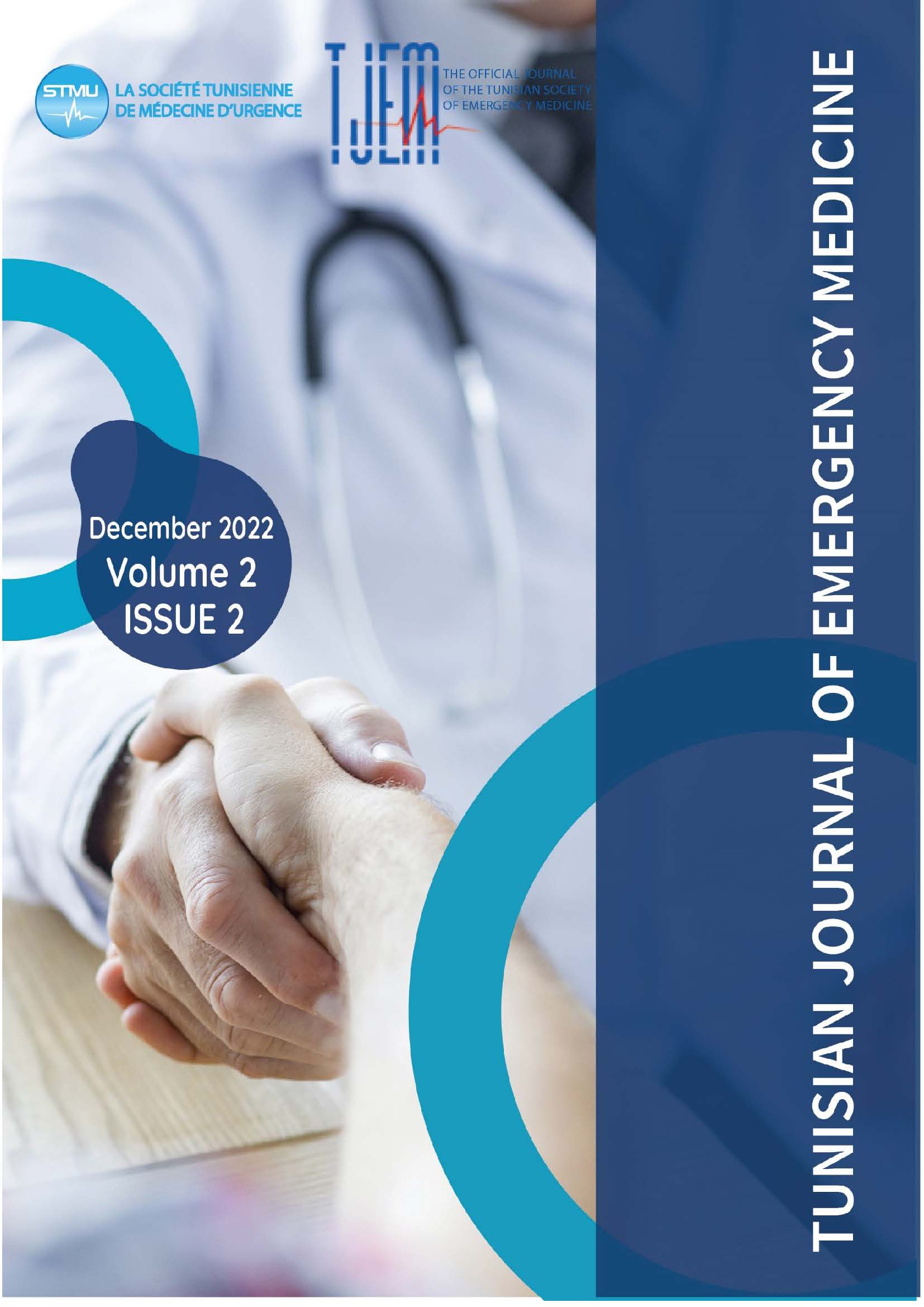Importance of Simulation in setting up ultrasoundguided vascular access
Ikhlass BEN AICHA, Yassine MEKSI, Rym YOUSSEF, Hajer YAAKOUBI, Lotfi BOUKADIDA, Asma ZORGATI, Riadh BOUKEF
DOI:
https://doi.org/10.0000/dgxfx120Keywords:
Simulation,, Ultrasound, Vascular access, Emergency department, critical care, Peritraumatic distress inventoryAbstract
Background: Simulation is considered a major educational tool in medical practice as well as in the
acquisition of technical and non-technical skills. Similarly, ultrasound takes an important place in the
world of simulation, in particular for the realization of vascular access in emergencies and intensive care
units. Ultrasound-guided vascular access is an invasive and precise gesture, hence the objective of
evaluating the contribution of simulation in the success of ultrasound-guided vascular access and the
stress management of the learners.
Materials and methods: This study aimed to assess the learning of the ultrasound-guided vascular
access gesture and the stress management by simulation among medical residents, from emergency,
medical and surgical resuscitation departments. We based on the Heart Rate (HR), the ENS score, the
STAI score, and the PDI score measurement before and after simulation, during 03 simulation sessions,
within a Tunisian university hospital. Sessions were animated by 02 monitors using a simulator vascular
access and an ultrasound machine equipped with a high-frequency linear probe.
Results: 20 residents were included. During the evaluation, we found that (55%) of learners felt
discomfort with vascular access in general, (75%) have already participated in a simulation session, and
(90%) have already had a passage by intensive care units. We had 100% of satisfaction. A significant
statistical relationship was found between the decrease in HR and in the time taken to perform the gesture
after the simulation session (p = 0.001) and a significant decrease in the ENS score of each candidate (p
= 0.021). A significant decrease also in HR was objectified for participants who completed the procedure
for several passages nor the
variation of the PDI score interferes in any statistical analysis with the decrease of the HR or the time of
realization of the gesture.
Conclusion: Today the real challenge of simulation in medicine is to link the technical and pedagogic
quality of medical education. Our study made it possible to show a significant satisfaction of the learners
during the simulation session, in the pose of ultrasound-guided vascular access, the reduction of the time
of realization, and the positive effect of the simulation on the reduction of stress as being an omnipresent
factor.HR=heart rate, STAI=Stat Trait Anxiety Inventory, PDI= Peritraumatic distress inventory
ENS= numeric stress scale.
Downloads
Published
Issue
Section
License
Copyright (c) 2022 Tunisian Journal of Emergency Medicine

This work is licensed under a Creative Commons Attribution-NonCommercial-ShareAlike 4.0 International License.
How to Cite
Similar Articles
- Faten DHOUIB, Aimen Dammak, Faiza Safi, Fatma MHIRI, zied CHAARI, Successful Conservative Management of Penetrating Cervical Tracheal Injury: A Case Report , Tunisian Journal of Emergency Medicine: Vol. 3 No. 1 (2025): TJEM 2025: Vol.3 Issue 1
- Amira Sghaier, Marwa Toumia, Khaoula Bel Haj Ali, Adel Sekma, Kaouthar Beltaief, Zied Mezgar, Wahid Bouida, Riadh Boukef, Jamel Saad, Hamdi Boubaker, Mohamed Amine Msolli, Mohamed Habib Grissa, Semir Nouira, B-lines Ultrasonography Assessment by Nurses for the Diagnosis of Heart Failure in the Emergency Department , Tunisian Journal of Emergency Medicine: Vol. 2 No. 4 (2024): TJEM Vol2 Issue4
- Sarra Akkari , Emna Rachdi , Jalila Ben Khlil , Prognosis in COVID-19: Impact of Pre-hospital Emergency Care , Tunisian Journal of Emergency Medicine: Vol. 2 No. 4 (2024): TJEM Vol2 Issue4
- Sondes laajimi, haifa bradai, Nabil Chebbi, Dorra Loghmari , imen EL KISSI, Naoufel Chebili , rabeb Mbarek, Specific Features of Chest Pain in Young People treated in Prehospital Care , Tunisian Journal of Emergency Medicine: Vol. 3 No. 1 (2025): TJEM 2025: Vol.3 Issue 1
- Fatma MHIRI, Aimen Dammak, Faiza Safi, Oumaima KHARDENI , Faten DHOUIB, Olfa chakroun-walha, Diagnostic Challenges and Treatment Strategies in Axillary Trauma: A Case Report , Tunisian Journal of Emergency Medicine: Vol. 2 No. 4 (2024): TJEM Vol2 Issue4
- Sirine Bouzid, Rim Karray, Amine Abdelhedi, Fadhila Issaoui, Olfa Chakroun, Noureddine Rekik, MULTIVISCERAL DAMAGE FOLLOWING ACUTE METHOTREXATE INTOXICATION BY DOSING ERROR , Tunisian Journal of Emergency Medicine: Vol. 3 No. 1 (2025): TJEM 2025: Vol.3 Issue 1
- Rabeb Mbarek, Khouloud Hamdi, Sarra Soua, Hela Abroug, Sondes laajimi, haifa Bradai, Dorra Loghmari , Asma SRIHA, Semir Nouira, Prehospital Particularities of Covid-19 infection and factors associated with its severity during the omicron variant wave (East-center of Tunisia) , Tunisian Journal of Emergency Medicine: Vol. 2 No. 4 (2024): TJEM Vol2 Issue4
- Marwa TOUMIA, Fatma Zaouali, Lamia Bouzgarrou, Guillain–Barré syndrome after an asymptomatic COVID‐19 Infection: a case report , Tunisian Journal of Emergency Medicine: Vol. 3 No. 1 (2025): TJEM 2025: Vol.3 Issue 1
- Faiza Safi, Traditional Medicine with Cade Oil in Pediatric Emergency Care , Tunisian Journal of Emergency Medicine: Vol. 2 No. 4 (2024): TJEM Vol2 Issue4
- Rania Hammami, Syrine Triki, Aimen Dammak, Faiza Safi, Olfa Chakroun , An abrupt cardiogenic shock in a female at the era of COVID 19 pandemic lockdown , Tunisian Journal of Emergency Medicine: Vol. 3 No. 1 (2025): TJEM 2025: Vol.3 Issue 1
You may also start an advanced similarity search for this article.

